Chronology
| 1843 |
Joseph Hardy Neesima, the founder of Doshisha, is born in Edo (Tokyo). |
|---|---|
| 1864 |
Neesima stows away on an American schooner bound for the United States, risking capital punishment for violating Japanese law, in order to pursue his dream of seeing the world and learning about Christianity. |
| 1865 |
Neesima arrives in the port of Boston and enters Phillips Academy in Andover, Massachusetts |
| 1866 |
Neesima is baptized at the chapel in Andover Theological Seminary. |
| 1867 |
Neesima completes his study at Phillips Academy and enters Amherst College. |
| 1870 |
Neesima graduates from Amherst College with a Bachelor of Science and enters Andover Theological Seminary. |
| 1874 |
Neesima graduates from Andover Theological Seminary. At the 65th American Board Annual Meeting held at Rutland in Vermont, he appeals for funds to establish an institution of higher education based on Christianity in Japan, and obtains a pledge of $5,000. He returns to Japan for the first time in 10 years. |
| 1875 |
Doshisha Academy is established on Teramachi Campus with eight students and two teachers, Neesima and J. D. Davis. 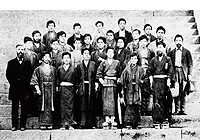 |
| 1876 |
Campus is relocated from Teramachi to Imadegawa. |
| 1877 |
Establishment of Doshisha Girls’ School is approved by Kyoto Prefecture. |
| 1879 |
The first 15 students graduate from Doshisha Academy. |
| 1883 |
Rules of the School are established. |
| 1884 |
Shoeikan (designated a national important cultural property) is completed as the first brick building on campus. 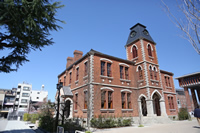 |
| 1886 |
Doshisha Chapel (designated a national important cultural property) is completed.  |
| 1887 |
Library opens at Shojakukan, the present Yushukan (designated a national important cultural property). Doshisha Hospital and Kyoto Training School for Nurses are established. 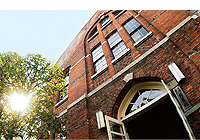 |
| 1888 |
‘The Aim in Establishing Doshisha University’ is published in major newspapers and magazines. |
| 1890 |
Joseph Hardy Neesima passes away at the age of 46. Harris Science Hall (designated a national important cultural property) is completed with the donation of $100,000 contributed by Sir J. N. Harris, an American businessperson. Harris Science School is established. 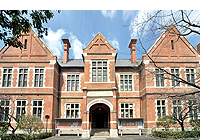 |
| 1893 |
Doshisha emblem is adopted. |
| 1894 |
Clarke Divinity Hall, the present Clarke Memorial Hall (designated a national important cultural property), is inaugurated. 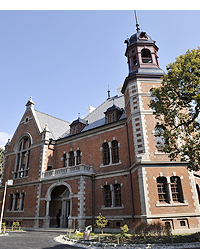 |
| 1909 |
Doshisha College Song is officially adopted. |
| 1912 |
Doshisha University (School of Theology, Faculty of Political Science and Economics and Department of English) and the Advanced Course of Doshisha Girls’ School are approved under the Senmon Gakko (professional school) Ordinance. |
| 1920 |
Doshisha University (Faculty of Letters, Faculty of Law, Graduate School and Preparatory School) is approved under the University Ordinance. |
| 1940 |
Joseph Hardy Neesima Memorial Monument (Ryoshinhi) is erected in the courtyard in front of Yushukan. 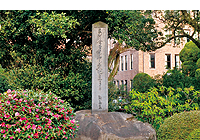 |
| 1944 |
Doshisha Engineering College is established. |
| 1948 |
Universitiy (School of Theology, Faculty of Letters, Faculty of Law, Faculty of Economics) is approved under the New School System Ordinance. |
| 1949 |
Faculty of Commerce and Faculty of Engineering are established. |
| 1950 |
Master’s Programs (Graduate Schools of Theology, Letters, Law, Economics, and Commerce) are established. |
| 1953 |
Doctoral programs are established. |
| 1955 |
Master’s program in Engineering is established. |
| 1975 |
A ceremony commemorating the centennial of the school’s founding is held. |
| 1986 |
Tanabe Campus, the present Kyotanabe Campus, is opened and the classes of Doshisha University and Doshisha Women’s College of Liberal Arts start there. |
| 1991 |
Graduate School of American Studies is established. |
| 1995 |
Graduate School of Policy and Management is established. |
| 1999 |
Center for Japanese Language is established. |
| 2000 |
Doshisha Biwako Retreat Center is completed in Kitakomatsu, Shiga Prefecture. |
| 2004 |
Faculty of Policy Studies, Department of Information Systems Design and Department of Environmental Systems Science in Faculty of Engineering, Law School, and Graduate School of Business are established. |
| 2005 |
Faculty of Culture and Information Science is established. |
| 2006 |
Doshisha Elementary School is established. Gakken Toshi Campus is opened. 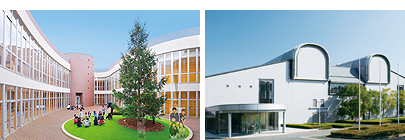 |
| 2007 |
Graduate School of Culture and Information Science is established. |
| 2008 |
Faculty of Engineering is reorganized as Faculty of Science and Engineering. |
| 2009 |
Faculty of Psychology and Graduate School of Psychology are established. |
| 2010 |
Graduate School of Grobal Studies is established. |
| 2011 |
Faculty of Global Communications is established. |
| 2012 |
Graduate School of Brain Science is established. |
| 2013 |
Faculty of Global and Regional Studies is established. |
| 2014 |
Master’s Degree Program ‘Global Business and Management Studies’ established in Doshisha Business School |
| 2015 |
Doshisha Kyotanabe Kaido (Kotoba-kan, Hikari-kan) completed. 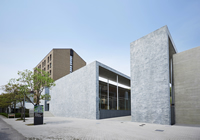 |
| 2017 |
Doshisha EU Campus at Tübingen University is opened. |
| Related Information |
Chronology of the Doshisha The website of The Doshisha introduces the history of Doshisha University together with the history of its schools and colleges. |
|---|